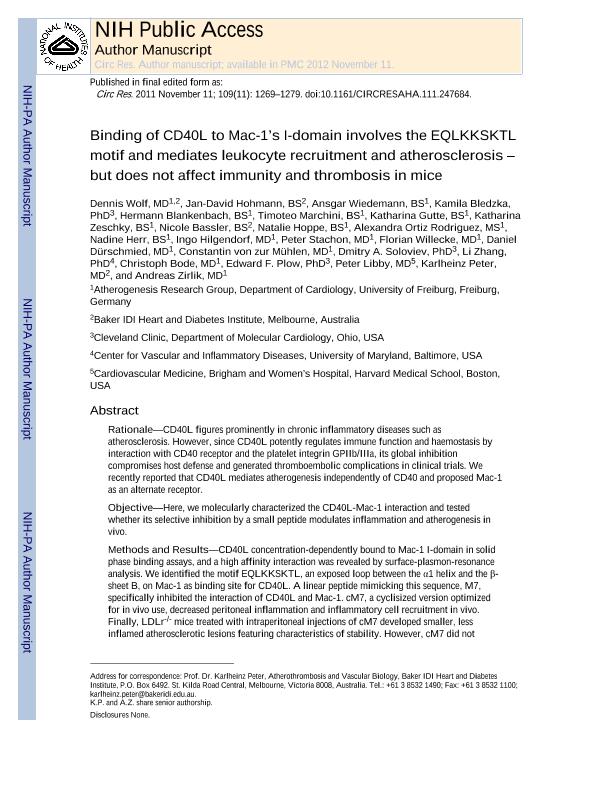Artículo
Binding of CD40L to Mac-1's i-domain involves the EQLKKSKTL motif and mediates leukocyte recruitment and atherosclerosis-but does not affect immunity and thrombosis in mice
Wolf, Dennis; Hohmann, Jan David; Wiedemann, Ansgar; Bledzka, Kamila; Blankenbach, Hermann; Marchini, Timoteo Oscar ; Gutte, Katharina; Zeschky, Katharina; Bassler, Nicole; Hoppe, Natalie; Rodriguez, Alexandra Ortiz; Herr, Nadine; Hilgendorf, Ingo; Stachon, Peter; Willecke, Florian; Duerschmied, Daniel; von zur Muhlen, Constantin; Soloviev, Dmitry A.; Zhang, Li; Bode, Christoph; Plow, Edward F.; Libby, Peter; Peter, Karlheinz; Zirlik, Andreas
; Gutte, Katharina; Zeschky, Katharina; Bassler, Nicole; Hoppe, Natalie; Rodriguez, Alexandra Ortiz; Herr, Nadine; Hilgendorf, Ingo; Stachon, Peter; Willecke, Florian; Duerschmied, Daniel; von zur Muhlen, Constantin; Soloviev, Dmitry A.; Zhang, Li; Bode, Christoph; Plow, Edward F.; Libby, Peter; Peter, Karlheinz; Zirlik, Andreas
 ; Gutte, Katharina; Zeschky, Katharina; Bassler, Nicole; Hoppe, Natalie; Rodriguez, Alexandra Ortiz; Herr, Nadine; Hilgendorf, Ingo; Stachon, Peter; Willecke, Florian; Duerschmied, Daniel; von zur Muhlen, Constantin; Soloviev, Dmitry A.; Zhang, Li; Bode, Christoph; Plow, Edward F.; Libby, Peter; Peter, Karlheinz; Zirlik, Andreas
; Gutte, Katharina; Zeschky, Katharina; Bassler, Nicole; Hoppe, Natalie; Rodriguez, Alexandra Ortiz; Herr, Nadine; Hilgendorf, Ingo; Stachon, Peter; Willecke, Florian; Duerschmied, Daniel; von zur Muhlen, Constantin; Soloviev, Dmitry A.; Zhang, Li; Bode, Christoph; Plow, Edward F.; Libby, Peter; Peter, Karlheinz; Zirlik, Andreas
Fecha de publicación:
11/2011
Editorial:
American Heart Association
Revista:
Circulation Research
ISSN:
0009-7330
Idioma:
Inglés
Tipo de recurso:
Artículo publicado
Clasificación temática:
Resumen
Rationale: CD40L figures prominently in chronic inflammatory diseases such as atherosclerosis. However, since CD40L potently regulates immune function and hemostasis by interaction with CD40 receptor and the platelet integrin GPIIb/IIIa, its global inhibition compromises host defense and generated thromboembolic complications in clinical trials. We recently reported that CD40L mediates atherogenesis independently of CD40 and proposed Mac-1 as an alternate receptor. Objective: Here, we molecularly characterized the CD40L-Mac-1 interaction and tested whether its selective inhibition by a small peptide modulates inflammation and atherogenesis in vivo. Methods and Results: CD40L concentration-dependently bound to Mac-1 I-domain in solid phase binding assays, and a high-affinity interaction was revealed by surface-plasmon-resonance analysis. We identified the motif EQLKKSKTL, an exposed loop between the α1 helix and the β-sheet B, on Mac-1 as binding site for CD40L. A linear peptide mimicking this sequence, M7, specifically inhibited the interaction of CD40L and Mac-1. A cyclisized version optimized for in vivo use, cM7, decreased peritoneal inflammation and inflammatory cell recruitment in vivo. Finally, LDLr -/- mice treated with intraperitoneal injections of cM7 developed smaller, less inflamed atherosclerotic lesions featuring characteristics of stability. However, cM7 did not interfere with CD40L-CD40 binding in vitro and CD40L-GPIIb/IIIa-mediated thrombus formation in vivo. Conclusions: We present the novel finding that CD40L binds to the EQLKKSKTL motif on Mac-1 mediating leukocyte recruitment and atherogenesis. Specific inhibition of CD40L-Mac-1 binding may represent an attractive anti-inflammatory treatment strategy for atherosclerosis and other inflammatory conditions, potentially avoiding the unwanted immunologic and thrombotic effects of global inhibition of CD40L.
Palabras clave:
Atherosclerosis
,
Cd40l
,
Inflammation
,
Mac-1
,
Peptide Inhibitor
Archivos asociados
Licencia
Identificadores
Colecciones
Articulos(IBIMOL)
Articulos de INSTITUTO DE BIOQUIMICA Y MEDICINA MOLECULAR
Articulos de INSTITUTO DE BIOQUIMICA Y MEDICINA MOLECULAR
Citación
Wolf, Dennis; Hohmann, Jan David; Wiedemann, Ansgar; Bledzka, Kamila; Blankenbach, Hermann; et al.; Binding of CD40L to Mac-1's i-domain involves the EQLKKSKTL motif and mediates leukocyte recruitment and atherosclerosis-but does not affect immunity and thrombosis in mice; American Heart Association; Circulation Research; 109; 11; 11-2011; 1269-1279
Compartir
Altmétricas



